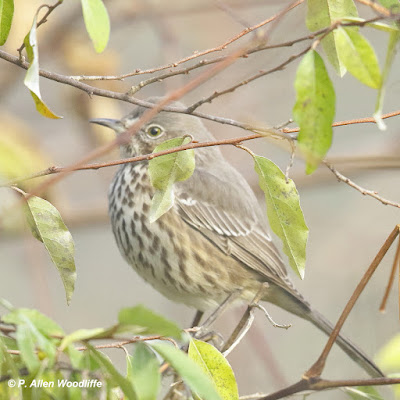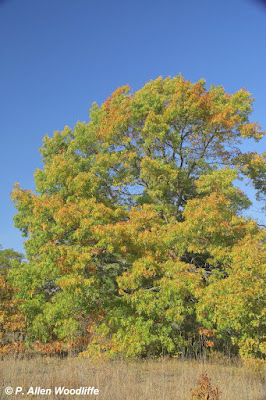It continues to be an interesting time of year for various reasons. The bird contingent is changing, as are the forest colours, and lakes are going through their seasonal turnover.
While many bird species have moved on to more southern destinations, the autumn species are showing up in greater numbers.
White-throated Sparrows are fairly common.....
....and surprisingly, Fox Sparrows are as well. In fact, in my last few forays around Rondeau, I have seen far more Fox Sparrows than White-throats. On one outing, I saw a minimum of 35 Fox Sparrows. They were mostly in two loose flocks, but a few individuals were seen scattered about elsewhere.
If you can find a puddle in a quiet area, there is a good chance birds will stop by, such as this Fox Sparrow....
....as were these Cedar Waxwings. As I was partially hidden in some brushy vegetation, and remained quite motionless, I noted more than a dozen birds of several species coming and going quite regularly.
I liked this trio of waxwings, with the central one sipping a drink and being nicely balanced by the two others.
Golden-crowned Kinglets are becoming more abundant than their Ruby-crowned cousins, as expected for this time of year. They can be challenging to get a photo of, as they seem to be constantly in motion.
While Black-capped Chickadees can be found even during the breeding season, they are not plentiful at that time. However their numbers are increasing now as more northern individuals are passing through, or maybe planning to stick around for the winter.
Carolina Wrens are year round residents, most often found in tangles of vegetation. Their numbers fluctuate, depending on the severity of the winter.
Yellow-rumped Warblers are still around in small numbers, and some may stick around all winter if they can find enough berries and spiders to subsist on.
A late Blue-gray Gnatcatcher and Black-throated Blue Warbler have both been seen in the campground recently, but I have not caught up to them yet.
Waterfowl are quite abundant, with often several thousand of several species scattered across Rondeau Bay. In quieter ponds, such as at Keith McLean Conservation Lands, species like Hooded Mergansers can be abundant. On one outing a quick count resulted in 87 individuals that I could see, with likely more in some more out of the way areas.
Also at KMCL is this pair of Bald Eagles, with the male on the left, and the larger, female on the nest. It looks like the female is about a 4th year bird, given its dusky head.
One or both have been seen perched on this platform for a few days in a row. In southern Ontario, late November and into December is typically the time when eagles either repair existing nests, or begin to build a new one. It is possible that this pair is planning to make use of this platform in 2022, usurping the long-gone Osprey pair that used it in 2021. It may be a new pair that has come into the area, especially since it seems to involve a 4th year bird. Birds as young as 3rd year can pair up, but this is more likely to happen when the population is very low. Now that the population has grown considerably in the past 2-3 decades, birds that pair up and start to nest are likely at least 4th year birds. They don't get their full adult plumage of bright white head and tail until their 5th year.
Back on about the last day of October, Steve C, Mike B and I spent some time at Erieau, watching for gulls and other waterbirds to fly by on the brisk winds. While there wasn't anything all that unexpected, we did get distracted by this dark gull on the pier. What made it stand out was that it appeared a lot like a first year Herring Gull, but it had some definite differences. It was darker than a normal first year HEGU, as well as being smaller than those HEGU quite close by. It also has dusky legs and a smaller head and bill, additional characteristics that didn't quite fit.

We puzzled over it and never quite came up with a definitive
identification on the spot. Fortunately the photos that both Mike and I took ended
up being helpful in order to study the bird and compare it with various
gull reference materials. It was interesting that when I posted it on
iNaturalist for its computer visualization process, it came up with
various options, but Herring Gull was way down the list, so that added
to the puzzlement. We eventually thought it must be some unusual type of
Herring Gull, and at first thought it might be the Atlantic Coast type,
as some characters fit. There had been several Atlantic seabirds show up in eastern Ontario, so why not an Atlantic Herring Gull?

I sent the photos to a gull expert in the Toronto area, who has had
considerable experience with them along Lake Ontario and elsewhere,
especially in the region of Niagara Falls which annually hosts thousands
of gulls. He indicated it was a Herring Gull, but not one that was
hatched anywhere in southern Ontario. Apparently birds hatched in the
northern parts of Ontario and Canada are typically darker, smaller and
with a smaller bill and dusky legs. Mystery solved.
The Sage Thrasher has continued, at least for a few more days, along the Mitchell's Bay South Lakeshore Trail, although not seen as regularly in the last few days. Views continue to be partial due to the branches, although there are fewer leaves to contend with as the days go by.
The bird was not reported for a day or two, but when I was out on Nov 18, after about two hours and checking an area a little way from its usual tangle, I spotted some movement, determined it was the bird in question, and managed this one photo. All of my other attempts were messed up with branches and leaves. There have been birders out there since, but to my knowledge, no one has seen it since, at least according to eBird.
It likely isn't too far away as there is a long stretch of shrubs and berries along that dredged ditch. Given how furtive the bird has been even at the best of times, it may be very difficult to find again.
On one occasion after I left the site of the Sage Thrasher, I meandered down the back roads towards St. Clair NWA. I noted a large falcon flying low and around a cedar hedge, but couldn't quite catch up to it for a photo. I sped up to the end of the cedar hedge and waited, with camera in hand. The falcon didn't quite get to the end before it peeled off and headed across a field, continuing to fly quickly and relatively low. I got off a couple of distant photos, but didn't manage to capture much detail. What follows next is the best I could do, and it really wasn't very helpful. When I posted it on iNat, the CV came up with Prairie Falcon, which would be quite unusual but not impossible. Prairie Falcon is a western species, of course, and moments ago I had come from viewing a definite western species, the Sage Thrasher, so why not a Prairie Falcon. However the detail is just not sufficient to make any kind of accurate ID, and it is most likely a juvenile Peregrine Falcon. Probably.....or not.

November happens to be one of the windiest months of the year, as is March. It is not unusual to see this along the lake front.
And now this cement structure has become visible again. It is part of where the camp office structure was located, back in the day when there was a south campground in operation at Rondeau in the 1960s and very early 1970s. Eventually the sand will shift and it may be covered up again, but for now it is at least partially exposed. Such is life on a sandspit.
There have been some mighty fine colours to enjoy in places at Rondeau.
It is obvious why this one is called Red Maple.
Closely related is Sugar Maple. It was in prime condition for a very short time, as a brisk wind blew most of the leaves off a couple of days later.
More subtle are the seed heads of an uncommon prairie plant, Cylindrical Blazing-star, which is widespread across the southeast beach dune area.
On one of the days I was roaming Rondeau and it was pleasantly warm, I saw a few Eastern Garter Snakes basking on the pavement. Unfortunately more than one had been schmucked by a vehicle of some sort, but this individual was still okay when I last saw it.
And finally, some of the oaks were in fine shape. I had been particularly focusing on Black Oak for a photo project I was working on, paying close attention to several that were especially photogenic for various reasons. This first one is along the southeast beach, and was looking promising on this occasion.
Five days later it looked like this, showing the golden brown colours this species is known for.
The campground has a lot of Black Oaks, and were relatively colourful on one of my last visits, but by now most will have turned to a deep dark brown, or will have fallen off altogether.
If you want to subscribe, or unsubscribe, to Nature Nuggets, send an email to: prairietramper@gmail.com































































